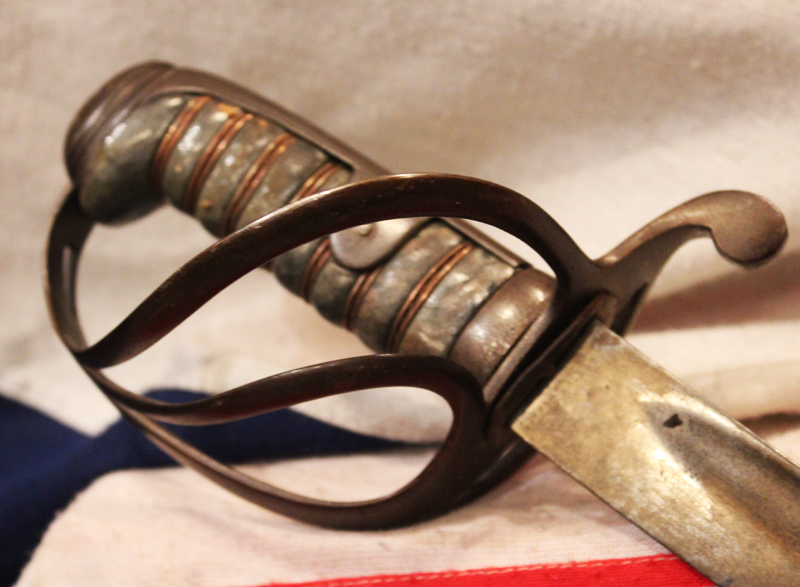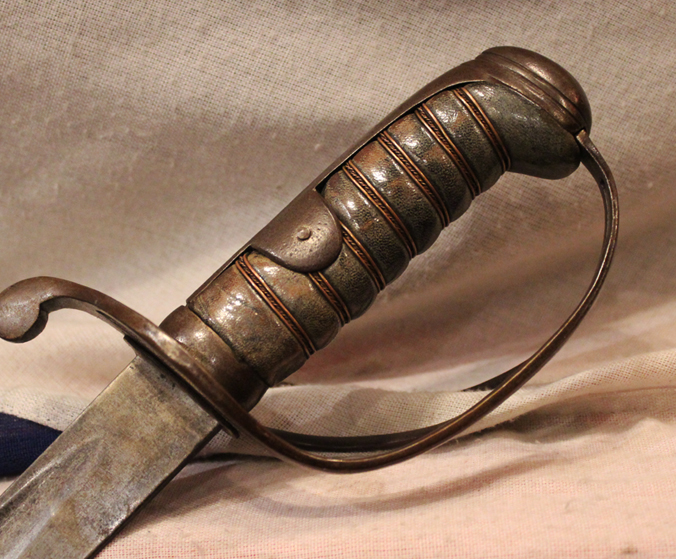A Superb 1821 Pattern, Victorian British Trooper's or NCO's Light Cavalry Sabre, For Light Dragoon's, Lancer's or Hussars. Used in the Crimean War, Such As the Infamous and Renown 'Charge of the Light Brigade'. Ordnance Issue
In superb naturally aged and patinated condition. excellent fishkin grip, wire bound.
The predecessor to the regulation later 1853 pattern, that was issued to sme regiments immediately at the start of the Crimean war, but not though issued to all mounted regiments. Some regiments continually used the 1821 pattern, and others the 1853.
A most impressive sabre, and very good indeed. The very type of ordnance made and issued Hussar's and Lancer's trooper's sabre, and Horse Artillery, used by British Cavalry in the ill fated charge in the Crimean War against Russia.
All steel three bar steel hilt, combat blade with fine-fishskin ribbed grip with original copper triple wire binding, which indicates it may have been issued to NCO's {sergeants and above}, as basic other ranks ordnance swords had regular utility leather bound grips.
Absolutely used at the time, and used, by all the serving NCO's of the light cavalry in the famous 'Charge'.
In the Crimean War (1854-56), the Light Dragoons were in the forefront of the famous Charge of the Light Brigade, immortalised by Tennyson's poem of that name ("Into the valley of death rode the six hundred").
The regiments adopted the title hussars at this time, and the uniform became very stylish, aping the hussars of the Austro-Hungarian army. But soon the blues and yellows and golds gave way to khaki as the British army found itself in skirmishes throughout the far-flung Empire, in India and South Africa especially.
For example in 1854 the 13th Hussars regiment received its orders from the War Office to prepare for service overseas. Five transport ships - Harbinger, Negotiator, Calliope, Cullodon, and the Mary Anne ? embarking between the 8 May and 12 May, carried 20 officers, 292 other ranks and 298 horses. After a
troubled voyage, the regiment arrived at Varna, Bulgaria on the 2 June. On the 28 August the entire Light Brigade (consisting of the 4th Light Dragoons and 13th Light Dragoons, 17th Lancers, the 8th Hussars and 11th Hussars, under the command of Major General the Earl of
Cardigan) were inspected by Lord Lucan; five men of the 13th had already succumbed to cholera.
On the 1 September the regiment embarked for the Crimea - a further three men dying en-route.
On the 20 September the regiment, as part the Light Brigade, took part in the first major engagement of the Crimean War, the Battle of the Alma. The Light Brigade covered the left flank, although the regiment?s role in the battle was minimal. With the Russians in full retreat by late afternoon, Lord Lucan ordered the Light Brigade to pursue the fleeing enemy.
However, the brigade was recalled by Lord Raglan as the Russians had kept some 3,000 uncommitted cavalry in reserve.
During the 25 October the regiments, the Light Brigade, took part in the Battle of Balaclava and the famous Charge of the Light Brigade.
The 13th Light Dragoons formed the right of the front line. The 13th and 17th moved forward; after 100 yards the 11th Hussars, in the second line, also moved off followed by the 4th and 8th.
It was not long before the brigade came under heavy Russian fire. Lord Cardigan, at the front of his men, charged into the Russian guns receiving a slight wound. He was soon followed by the 13th and 17th. The two squadrons of the 13th and the right squadron of the 17th were soon cutting down the artillerymen that had remained at their posts. Once the Russian guns had been passed, they engaged in a hand-to-hand fighting with the enemy that was endeavoring to surround them by closing in on either flank.
However, the Light Brigade having insufficient forces and suffering heavy casualties, were soon forced to retire. Capt. Louis Edward Nolan (January 4 1818-October 25 1854), who was a British Army officer of the Victorian era, an authority on cavalry tactics, and best known for his controversial role in launching the disastrous Charge of the Light Brigade during the Battle of Balaclava. He was the first casualty of that engagement. No scabbard. Great all round steel condition, and excellent grip patina.
Code: 20877
685.00 GBP



